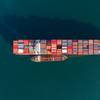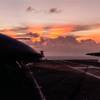This Day in Coast Guard History – September 15
1944- Coast Guardsmen participated in the invasion of Morotai Island.
1948- After making a night-long high speed run to reach the hurricane-ridden Portuguese schooner Gasper some 300 miles off the southern tip of Newfoundland, USCGC Bibb launched two 20-man rubber lifeboats in heavy rain and seas to rescue 40 survivors and 1 dog from the doomed ship.
1958- A New Jersey Central passenger train plunged into Newark Bay through an open drawbridge, submerging two engines and two coaches. Coast Guard small craft and helicopters assisted in rescuing 43 survivors and recovering 29 bodies.
1995-Hurricane Marilyn made landfall, cutting a path of destruction across the U.S. Virgin Islands. GANTSEC Command Center coordinated the SAR efforts. HH-65As from AIRSTA Borinquen rescued survivors from two vessels that sank during the storm. CGC Escanaba also participated in the SAR operation and then supported the relief efforts in St. Thomas. CGC Vigorous relieved Escanaba on 18 September. The CGC Point Ledge, homeported in St. Thomas, had been washed up on the city's seawall by the heavy storm surge, causing considerable damage. None of her crew were injured, however. Members of LEDET Miami and TACLET members from Miami and San Juan were flown to St. Thomas to help enforce a curfew, provide airport security and help stand watch on the grounded Point Ledge. Coast Guard aircraft also flew overflights to survey the damage and delivered relief supplies. In 10 days the aircraft delivered more than 410,000 pounds of relief supplies and transported 260 federal recovery workers to St. Thomas. MSD St. Thomas supervised all maritime recovery operations, facilitated maritime traffic for a community dependant on maritime commerce, responded to the massive environmental impacts, and were the DoT's representative for the initial standup of the EOC. ANT San Juan and the CGC Laurel were also sent to assist in the cleanup.
2001- Coast Guard units and local agencies responded to a bridge collision on the Intracoastal Waterway after the tug Brown Water V and its four barges struck the Queen Isabella Causeway, the longest bridge in Texas. The collision caused a 240-foot section of the causeway to collapse, spilling 10 cars into the water and killing five persons. Station South Padre Island deployed two 27- foot boats, a 41-foot boat and a 21-footer. Other vessels pulled 13 survivors from the water and transferred them to the Coast Guard craft. The CGC Mallett was later used as a rescue platform to retrieve the submerged vehicles and victims.
(Source: USCG Historian’s Office)












